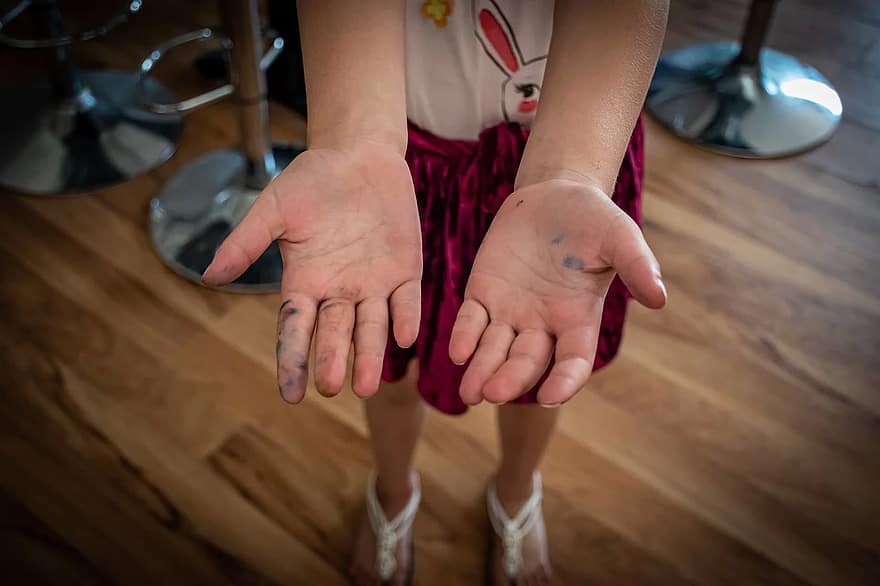Step 1
Boil the water in a pan.
Step 2
Add the gelatin powder to the water until all of the gelatin has dissolved.
Step 3
Whilst still hot, pour the gelatin into the petri dish until it is around ⅓ full. Repeat for the other petri dish.
Step 4
Place in the fridge, with the lid on, for around 12 hours, until the gelatin solidifies.
Step 5
Remove from the fridge and then slightly press your thumb on the gelatin and place the lid back on. For safety reasons, seal the containers tightly with the sticky tape. Label the petri dishes with the date and mention in which petri dish the hand sanitizer was utilized.
Step 6
Rub your hands with the hand sanitizer and repeat step 5 using your ‘clean’ hand.
Step 7
Leave for a few days (around 3-7 days) in a dark room at room temperature until multiple spots appear on the gelatin. These are the bacterial colonies.
Step 8
If you happen to have a compound or stereo microscope, try looking at the different bacterial colonies up close.
Step 9
Observe whether the hand sanitizer has reduced the number of bacterial colonies present on your hand.
If you don’t have petri dishes, don`t worry. Other items can be used to grow your bacterial colonies such as foil muffin cups. For this you might want to use sandwich bags in order to then seal the muffin cups containing the gelatin.
You might also want to utilise small jars such as jam jars or baby food jars in order to grow the bacterial colonies.
Nutrient agar is a better medium for growing the bacterial cultures. So if you do have agar use this as a growing medium rather than gelatin.
Most environmental fungi and bacteria are not harmful towards healthy individuals. However, when they multiply they can become hazardous.
To protect yourself it is therefore important to wear safety gloves and to prevent breathing in or ingesting the growing bacteria.
http://www.sciencebuddies.org/science-fair-projects/project_ideas/Micro_Safety.shtml
This experiment requires boiling water. It is better to allow your supervisor to handle the boiling water.
It is important to tape the petri dishes to keep everything tightly sealed. Also, the sticky tape prevents any microorganisms from the air from getting into the petri dish and contaminating the culture.
Another precaution is to dispose of the petri dishes in a sealed plastic bag following completion of the experiment.
Why does your mother tell you to wash your hands right before you eat? And why do hospitals have posters everywhere to use hand sanitizers for disease control? Are you curious to find out if your hand is an assembly of microbes? Join this scientific adventure to answer these rather intriguing perhaps slightly disgusting questions.
What are bacteria?
Single celled prokaryotes which have membrane bound nucleus.
Why is gelatin used as a culture medium?
Contains nitrogen and carbon compounds necessary for bacterial growth.
What is the effect of the hand sanitizer on bacterial growth?
Inhibits bacterial growth..
What is a common bacterium that is present on the hand?
Staphylococcus epidermidis
What is a more efficient method of cleaning hands rather than using hand sanitizer?
Wash hands with soap and water.
Bacteria are amongst the earliest forms of life on this Earth. They have been calling earth their home for billions of years.
Bacteria are single-celled organisms lacking a membrane-bound nucleus and other internal structures. This classifies the bacteria as prokaryotes. https://www.britannica.com/science/bacteria
In this experiment, bacteria were allowed to grow on gelatin. The gelatin acts as a culture medium that the cultured bacteria feed on in order to multiply. Since the bacteria are unicellular they cannot be seen by the naked eye, however, after a few days of growing on gelatin, the bacteria become visible. This is because each bacterium present on the agar from the thumb grows into a visible colony that contains thousands of bacteria.
As our hands are so often in contact with the outside world, a variety of bacteria can be seen growing on the plate
The hand sanitizer is expected to effectively kill most of the bacteria present on the hand surface and so a reduction in the bacterial count is expected.
Washing the hand with soap and water is the most effective. However, alcohol based hand sanitizers can be used if soap and water are not available. https://www.cdc.gov/handwashing/show-me-the-science-hand-sanitizer.html
Alcohol-based hand sanitizers kill bacteria by:
- Changing their protein structures which disrupts the bacterial membrane.
- Dissolving the membrane covering the bacteria. This occurs since the membrane of bacteria is composed of lipids that are soluble in organic solvents such as certain alcohols.
Interestingly, the human hand possesses its own cleaning mechanism. The outer epidermal layer of the skin continuously sheds cells together with any attached microbes and replaces them. https://microbewiki.kenyon.edu/index.php/Human_Hands_and_Fingernails
Bacteria are single-celled organisms that are capable of inhabiting a variety of different environments such as soil, water, and our own intestines. Bacteria are classified as prokaryotes since they have no membrane-bound internal structures. http://www.livescience.com/51641-bacteria.html
Bacteria are capable of growing on any source of organic food that contains carbon and nitrogen. Carbon is essential for respiration and nitrogen is essential for the protein to build up. http://www.biotopics.co.uk/microbes/tech.html In this experiment the carbon and nitrogen were provided in the gelatin medium. This was used as a substitute for Agar. Agar is a polymer of the monosaccharide galactose and is better than gelatin because it is not degraded by the growing bacteria. http://www.sciencebuddies.org/science-fair-projects/project_ideas/MicroBio_Agar.shtml
Gelatin acted as a culture medium, meaning that the cultured bacteria can feed on it in order to multiply. Since the bacteria are unicellular they cannot be seen by the naked eye, however, after a few days on the gelatin, they multiply and become visible. This is as each bacterium present on the agar from the thumb grew into a visible colony that contains thousands of bacteria. Different types of bacteria show differences in colony morphology. These differences are used by scientists in order to describe the characteristics of the colonies observed. It is the colony morphology that might allow the identification of the bacteria.
According to the Centers for Disease Control and Prevention, washing hands with soap and water is the best way to reduce the numbers of microbes colonising the hand. An alternative to this washing technique is using the less efficient alcohol-based hand sanitizer (containing at least 60% of alcohol). https://www.cdc.gov/handwashing/show-me-the-science-hand-sanitizer.html
Alcohols are capable of killing bacteria by disrupting the lipid membrane. This causes the membrane to lose its structural integrity which in turn allows the alcohol to enter the cells to denature the proteins present. http://sciencing.com/alcohol-kill-bacteria-5462404.html
Alcohols are effective in killing bacteria however are not as effective to be utilized for the sterilization of medical equipment since they lack sporicidal action such as Clostridium spores. Additionally, it is claimed that a high percentage of alcohol enhances sporicidal activity (induces bacterial dormancy) rather than kills the bacterium.
https://www.cdc.gov/hicpac/disinfection_sterilization/6_0disinfection.html
A common bacteria found on the hand is Staphylococcus epidermidis, a Gram-positive bacterium that is part of the normal human flora. This typically is not harmful however for people with a compromised immune system, this bacterium can pose serious health risks such as the development of sepsis. https://en.wikipedia.org/wiki/Staphylococcus_epidermidis
Apart from bacteria, other types of microbes might be present such as fungi. Typically, fungi residing on the skin are not harmful but some can cause infection if they gain entry through a wound. A common fungal infection is ringworm caused by Tinea corporis (forms ringworm on the body) or Tinea capitis (Forms ringworm on the scalp). https://courses.lumenlearning.com/microbiology/chapter/mycoses-of-the-skin/
Applications
Different Agar types can allow for the identification of specific microbes such as Brilliant Green Agar that detects Salmonella spp. https://catalog.hardydiagnostics.com/cp_prod/Content/hugo/BrillGrnAgar.htm
Research
Research published in the Nature journal in the year 2012 showed that skin bacteria can lead to the subsequent boost in immunity. http://web.b.ebscohost.com.ejournals.um.edu.mt/ehost/results?sid=732ad57e-bd68-4014-bf41-73e81633a8a0%40sessionmgr103&vid=0&hid=125&bquery=(SO+(Nature))AND(DT+2012)AND(TI+microbiology%3a+skin+bacteria+boost+immunity)&bdata=JmRiPWE5aCZ0eXBlPTEmc2l0ZT1laG9zdC1saXZl
Research
A more recent study published in October 15 in the Journal of Food Science investigated the efficacy of chlorine sanitizer on inhibiting various types of Staphylococcus aureus biofilms on the surface of stainless steel.
http://web.a.ebscohost.com.ejournals.um.edu.mt/ehost/pdfviewer/pdfviewer?sid=38b87124-dc98-469f-9b36-3502dc065864%40sessionmgr4007&vid=1&hid=4206
Research
Another very intriguing research was conducted in Brazil which aimed at preparing a liquid crystalline system of GMO (genetically modified organisms) and water containing antibacterial compounds. This was done to evaluate their potential as drug delivery systems for topical treatment of bacterial infections.
https://link.springer.com/article/10.1208/s12249-016-0690-0
- A key in science is the power of creativity. Try using different non-toxic chemicals on your hand before conducting the experiment to see what is the most effective at killing bacteria. You might want to test if lemon juice has the ability to kill bacteria or maybe even white vinegar.
- Are you interested in knowing how dirty your house truly is? Then why not repeat the experiment but this time taking swabs of different areas of the house such as perhaps your bed or the toilet seat.
- We keep food in our fridge to prevent it from spoiling. Show the effectiveness of cold in controlling microbial growth by repeating the experiment but this time placing the Petri dishes in the fridge. Compare the results obtained with the bacterial growth at room temperature and see if the fridge does reduce the rate of bacterial growth.



